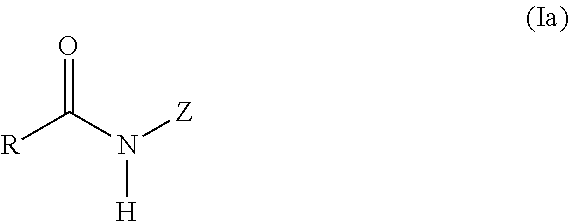Compositions and methods for the modulation of specific amidases for N-acylethanolamines for use in the therapy of inflammatory diseases
a technology of nacylethanolamine and amidases, which is applied in the direction of drug compositions, cardiovascular disorders, muscular disorders, etc., can solve the problems of complexes that affect the central nervous system, the regulatory role of enzymes intended to modulate the availability of substrates, such as pea, produced on demand by specific cells of organisms, and the adverse effects of compounding on the central nervous system
- Summary
- Abstract
- Description
- Claims
- Application Information
AI Technical Summary
Benefits of technology
Problems solved by technology
Method used
Image
Examples
example 1
Preparation of 2-pentadecyl-2-oxazoline (PEA-OXA)
[0033]3.0 g of N-(2-hydroxyethyl)palmitamide are suspended at 0° C. and under nitrogen gas atmosphere in 20 ml of SOCl2. The mixture is stirred at 0° C. for 30 minutes, then at ambient temperature for 15 hours. The solution thus obtained is dry evaporated at a low pressure. The residue is purified by crystallization from 15 ml of tert-butyl methyl ether, isolated and dried under vacuum. The crystallized product is suspended in 20 ml of anhydrous toluene and 1.3 g of potassium tert-butoxide are added. The mixture is heated at 40° C. for 2 hours, then it is cooled at 4° C. The solution is extracted 3 times using 6 ml of water and the extracts are disposed. The organic phase is dry evaporated at a low pressure and the residue is distilled under high vacuum at about 0.5 mm Hg. The fraction which distillates at about 175° C. and solidifies at ambient temperature is collected and preserved in inert atmosphere. (About 92% yield)
[0034]The 2-p...
example 2
Preparation of 2-heptadecyl-2-oxazoline (SEA-OXA)
[0035]3.28 g of N-(2-hydroxyethyl)octadecanamide are suspended at 0° C. and under nitrogen gas atmosphere in 20 ml of SOCl2. The mixture is stirred at 0° C. for 30 minutes, then at ambient temperature for 15 hours. The solution thus obtained is dry evaporated at a low pressure. The residue is purified by crystallization from 15 ml of ethyl acetate, isolated and dried under vacuum. The crystallized product is suspended in 20 ml of anhydrous toluene and 1.3 g of potassium tert-butoxide are added. The mixture is heated at 40° C. for 2 hours, then it is cooled at 4° C. The solution is extracted 3 times using 6 ml of water and the extracts are disposed. The organic phase is dry evaporated at a low pressure and the residue is distilled under high vacuum at about 0.01 mm Hg. The fraction which distillates at about 225° C. and solidifies at ambient temperature is collected and preserved in inert atmosphere. (About 90% yield)
[0036]The 2-heptad...
example 3
Preparation of 2-tridecyl-2-oxazoline (MEA-OXA)
[0037]2.72 g of N-(2-hydroxyethyl)myristamide are suspended at 0° C. and under nitrogen gas atmosphere in 20 ml of SOCl2. The mixture is stirred at 0° C. for 30 minutes, then at ambient temperature for 15 hours. The solution thus obtained is dry evaporated at a low pressure. The residue is purified by crystallization from 15 ml of tert-butyl methyl ether, isolated and dried under vacuum. The crystallized product is suspended in 20 ml of anhydrous toluene and 2.6 g of silver trifluoromethanesulfonate are added. The mixture is heated at 40° C. for 2 hours, then it is cooled at 4° C. The formed whitish precipitate is separated by filtration, the solution is extracted 3 times using 6 ml of water and the extracts are disposed. The organic phase is dry evaporated at a low pressure and the residue is distilled under high vacuum at about 0.5 mm Hg. The fraction which distillates at about 160° C. and solidifies at ambient temperature is collecte...
PUM
| Property | Measurement | Unit |
|---|---|---|
| temperature | aaaaa | aaaaa |
| temperature | aaaaa | aaaaa |
| temperature | aaaaa | aaaaa |
Abstract
Description
Claims
Application Information
 Login to View More
Login to View More - R&D
- Intellectual Property
- Life Sciences
- Materials
- Tech Scout
- Unparalleled Data Quality
- Higher Quality Content
- 60% Fewer Hallucinations
Browse by: Latest US Patents, China's latest patents, Technical Efficacy Thesaurus, Application Domain, Technology Topic, Popular Technical Reports.
© 2025 PatSnap. All rights reserved.Legal|Privacy policy|Modern Slavery Act Transparency Statement|Sitemap|About US| Contact US: help@patsnap.com



